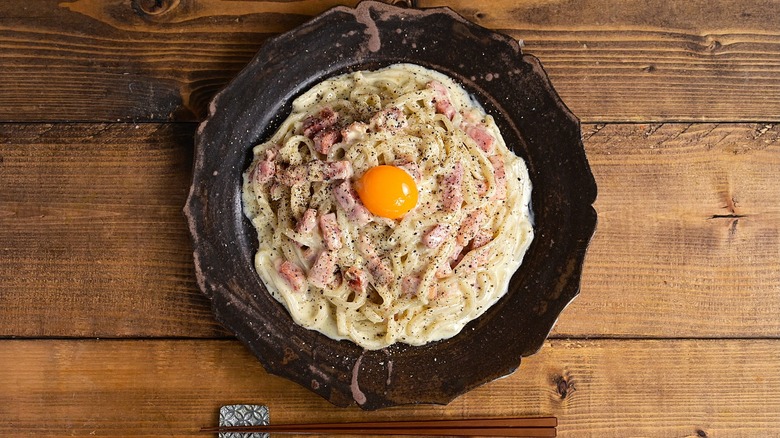Swap Italian Noodles With Udon For A Heartier Twist On Carbonara
Comforting, saucy, and aromatic, Italian food is a world-renowned cuisine you can enjoy from Sicily to San Francisco and everywhere in between. Although Italian pasta is typically made with noodles like spaghetti, penne, and fettuccine, there's nothing wrong with shaking things up by replacing traditional pasta shapes with noodles from different cultures and cuisines. Enter udon carbonara.
Carbona – a rich pasta dish fashioned with egg, cheese, and pork — is typically made with spaghetti or linguine noodles. Although the classic form of carbonara is tried, true, and timeless, swapping the dish's traditional noodles for Japanese udon noodles gives it an Asian-fusion twist that you'll find yourself returning to time and time again. Made from wheat flour, udon noodles have a high protein content which contributes to the development of gluten and helps give the noodles their characteristic chewiness. Once the dough has been stretched, worked, and rolled out, they are cut into much thicker shapes than common Italian pasta shapes. Thanks to their hearty size and pleasantly chewy texture, udon noodles can give this classic pasta dish a unique and substantial mouthful that will leave you feeling satiated and satisfied.
Although udon noodles are commonly used in Japanese soups and stir-fries, both udon and Italian noodles are made from wheat flour, ensuring that the flavor profile of the carbonara isn't vastly altered or compromised by this uncommon yet equally delicious noodle substitute.
How to perfectly cook udon noodles
In Italian cooking, how you prepare the dish's noodles can make or break the meal. Some recipes call for a well-cooked noodle, while others require an al dente finish. But how do you prepare udon noodles for a heaping plate of carbonara? For ease and accessibility, we'll focus on how to use store-bought udon noodles to make this dish.
If possible, opt for fresh udon noodles, as they have the highest quality texture. If you can't locate them at your go-to supermarket, you can find fresh udon noodles in the refrigerated section of Asian markets, specialty grocery stores, or various online retailers. Dry udon noodles are still great options for Asian-fusion carbonara, but they will have a less traditional texture than fresh ones. Fresh udon noodles can take up to three minutes to cook, while dry varieties can take up to ten minutes. You'll want the noodles to be tender and chewy, but never squishy.
Salting the water the noodles cook in can infuse them with flavor and prevent them from sticking together while they boil. Once they've reached your desired texture, drain and rinse the noodles with cold water to halt the cooking process and slough off any excess starches. Et voila — perfectly cooked udon noodles for a fresh take on a classic Italian dish.
Jazzing up udon carbonara
You can use udon noodles for a traditional carbonara recipe featuring the usual suspects. Between the creamy egg yolk, rich cheese, fatty pork, and thick noodles, you'll be in flavor heaven after the first bite. But udon carbonara is already a departure from Italian traditions, so why stop there when you can jazz up this Italian-Asian fusion pasta dish even further?
You don't need to memorize the ultimate guide to miso to add a spoonful to your udon carbonara. Introducing this umami-dense paste to the dish can bolster the savory spirit of the pork while inviting another Japanese staple into the mix. For another flavoring option, one of the best ways to use chili crisp at home is by slathering a tablespoon of this spicy, textured condiment into the miso-kissed udon carbonara for a touch of fire that cuts through richer ingredients.
Don't hesitate to experiment with classic herbs and spices commonly used in Asian cooking to develop an authentic aromatic atmosphere. Thai basil, with its spicy, anise-like flavor, offers a subtle hint of sweet pepperiness that adds dimension. Additionally, green onions make for the perfect edible garnish, bringing a mild, oniony crunch to the creamy dish.
Whether you zhuzh it up or not, udon noodles are a must-try ingredient for carbonara. The final question remaining is: should you use chopsticks or a fork to eat it?


